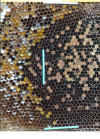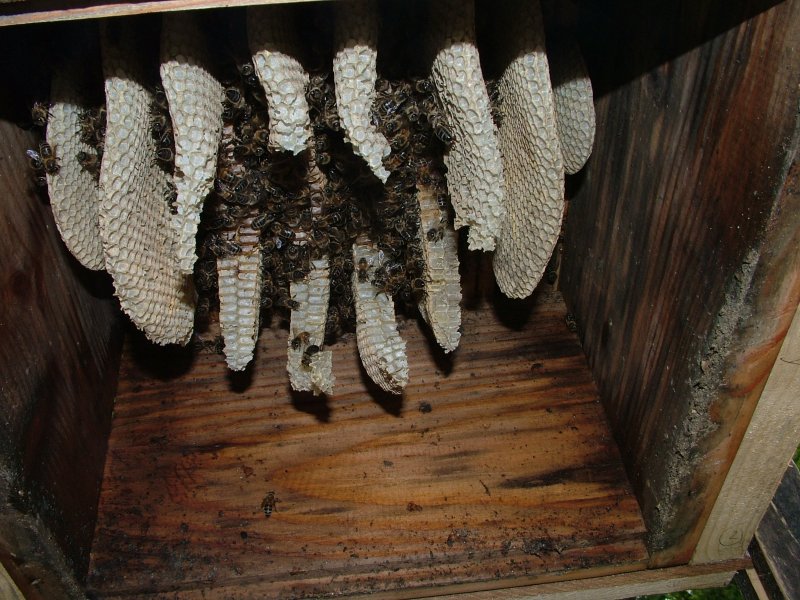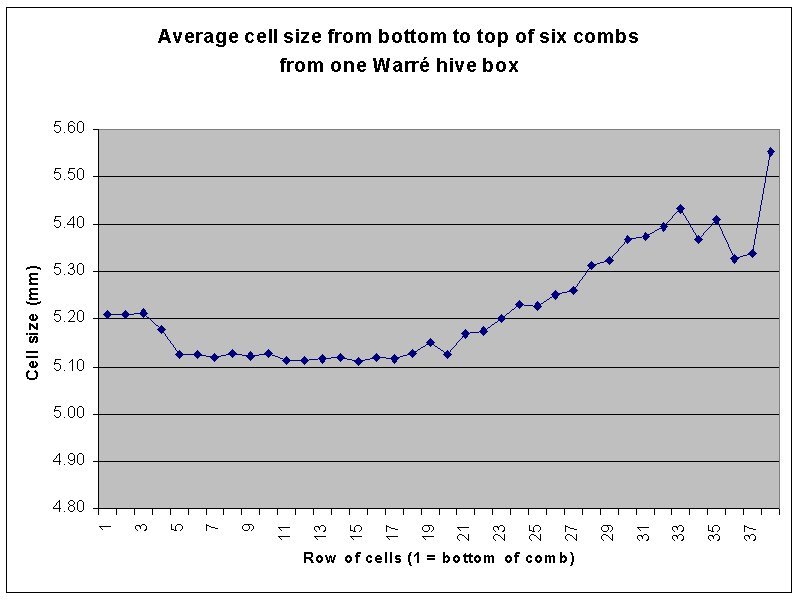 Click this thumbnail to view the full image.
Click this thumbnail to view the full image.Comb worker cell size measurements
Introduction
The suggestion that bees raised on comb with cells smaller than determined by conventional foundation may be better able to cope with Varroa1 has attracted the interest of apiculturists and apiologists alike. However, a number of experiments reported in peer-reviewed journals have failed to demonstrate any overall advantage of small cell comb based either on small cell (4.9 mm) foundation or made of plastic.2-7 A criticism made of these studies is that they are too short-term, the longest lasting being 13 months,4 whereas anecdotal evidence accumulated over two decades suggests that a combination of withdrawal of acaricides, natural selection and small cell comb needs to be applied for several years before a Varroa resistant population of bees is established.
An alternative approach has been to let bees build natural comb and develop their own preferred cell size range. In a study lasting three years, natural comb was compared with comb based on 5.3 mm cell size foundation regarding the survival, Varroa mite drop and productivity of the respective colonies.8 Perhaps surprisingly, the worker cell size of the natural comb colonies was larger (5.4 mm) than that of the foundation comb colonies (5.3 mm). No decrease in natural cell size was observed over the three years of the study.
If, despite the accumulating evidence to the contrary, small comb cells are essential to the ability of Apis mellifera to co-adapt with Varroa, it would be of particular interest to natural beekeepers if small cells are achievable by allowing colonies to develop on foundationless combs, i.e. by using only starter strips of unembossed beeswax. It is even conceivable that the selective pressure of Varroa could force Apis mellifera gradually to develop a cell size range which is smaller than the range that has been found in its natural comb throughout beekeeping history.
How raising bees in small cells would help them vis-à-vis Varroa is still largely a matter of speculation. One possibility is that the tightness of fit of pupae in cells may increase mite mortality.9 However, as the size of adult bees emerging from small cells is slightly reduced, this too may have as yet undocumented effects on colony health and vitality which enable the bees to resist Varroa.
Searches in the beekeeping literature over the past 340 years for reports on natural cell size show an overall average value of 5.3 mm.10 Authors who have reported worker cell size ranges for comb of bees that were unlikely to have ever been reared on foundation have observed a variety of minima: Cowan 4.72; Maraldi 4.92; Cheshire 5.08 and Root 5.21.10 Both Cowan and Maraldi gave different values in different places in their writings, so there must remain some uncertainty about the validity of their values.10 It is noteworthy that if values as low as 4.7 mm are a common property of natural comb then it differs greatly from the size of foundation. My locally purchased foundation has a cell size of 5.7 mm when measured horizontally, 5.4 mm in the two directions at 60º to the horizontal.
This paper reports measurements on the cell size of natural and near-natural comb in the author's locality (NW Wales) with a view to seeing if sizes below 5.0 mm are commonly encountered or even increase with time elapsed since the colonies concerned were kept on a foundationless system. In the Warré hive, new boxes are nadired (added under the brood nest). This allows successive generations of bees to grow the comb downwards and this may produce a gradually diminishing average cell size and the appearance of an increasing proportion of cells below 5.0 mm.
Methods
Cell size was measured in three different ways. Initially, it was with a good quality millimetre ruler that had been checked against other makes of ruler. After 22 February 2011 digital calipers were used where only a few measurements were required. Where cell size was measured row by row across whole combs measurements were made by photography, digitisation of landmark data and calculation by spreadsheet.
Combs were photographed in good light with a digital camera (Fuji S7000) placed 3 m from the comb and the lens aligned to the centre of the comb. The comb face and camera lens were adjusted to be perpendicular to the line between each. The camera was mounted on a tripod and fitted with cable release. Photos were taken in available light, either sunlight or tungsten filament or a mixture of the two. The diaphragm was stopped to F8 and the digital resolution set to 6 megapixels 'fine', the maximum available for the camera. The lens was set to maximum optical zoom.
Images were transferred to a computer, cropped to retain just the comb area and digitised using F. James Rohlf's 'tpsDig' software.11 Generally ten cells were measured for each row from the bottom to the top near the middle of the comb on both sides. Occasionally combs were curved. Where it was not possible to have ten cells per row orientated perpendicular to the line between comb face and camera, five cells were selected.
In order to calibrate the measuring setup, three plastic bars 50 mm long, measured with digital calipers, were pinned to the comb face. The positions of the ends of the bars and rows of 10 or 5 cells were digitised and saved to a *.tps data file. These data are the x,y coordinates of the points measured in pixels. The data were then imported into a Microsoft Excel spreadsheet, and, using the values for the three calibration bars the cell size calculated with the generation of mean, range and median statistics. The photographic method was verified with digital calipers and found to be in excellent agreement.
The following photo shows part of the landmarked image of a comb face with the three calibration bars pinned to it:
 Click this thumbnail to view the full image.
Click this thumbnail to view the full image.
Results
The results are summarised in the following table:
Cell size (mm) |
||||||||
| Date | Comb source | Age (y) | Comb identity | Mean | Min | Max | Median | xls spreadsheet |
| 20.1.07 | Feral in fallen oak, Llyn Hafod y Llyn | ? | 1 | 5.43 | 5.35 | 5.5 | 5.45 | |
| 2 | 5.53 | 5.45 | 5.7 | |||||
| 3 | 5.43 | 5.4 | 5.45 | |||||
| 8.10.07 | National frame with 1" foundation starter strip | 1 | 5.4 (bottom) | 5.8 (top) | ||||
| 19.3.09 | Warré 5 | 2 | 1 | 5.4 | 5.2 | 5.9 (top back) | 5.3 | |
| " | 2 | 5.4 | 5.4 | 5.4 | 5.4 | |||
| " | 5 | 5.4 | 5.2 | 5.6 | 5.4 | |||
| " | 6 | 5.4 | 5.2 | 5.8 | 5.3 | |||
| 19.3.09 | Warré 3 | 2 | 1 | 5.5 | 5.4 | 5.8 | 5.4 | |
| " | 4 | 5.4 | 5.2 | 5.8 | 5.3 | |||
| 19.3.09 | Warré 8 | 2 | 4 | 5.4 | 5.2 | 5.9 (top) | 5.2 | |
| " | 2 | 5.4 | 5.3 | 5.5 | 5.4 | |||
| " | 1 | 5.4 | 5.3 | 5.7 | 5.3 | |||
| 24.4.09 | Warré 4 | 2 | 5.3 | 4.8 | 5.7 | 5.4 | ||
| 26.6.09 | Warré 1 | 2 | B2 | 5.3 | 5.1 | 5.7 | 5.4 | |
| 14.4.10 | Warré 6 | 2 | B2, 5 combs | 5.2 | 5.0 | 5.7 | 5.4 | |
| 30.8.10 | Warré 3 | 1 | B1C3 | 5.4 | 5.3 (bottom) | 5.5 (top) | ||
| " | B2C4 | 5.4 | 5.2 (bottom) | 5.6 (top) | ||||
| 19.11.10 | Feral in water company valve chamber | 5.2 | 4.9 | 5.4 | 5.3 | |||
| 21.2.11 | Warré 11 | 3 | B1 | 5.2 | 5.15 | 5.25 | ||
| " (comb torn down & rebuilt in 2009) | 2 | B2 C4 Side 1 | 5.3 | 4.9 | 6.1 (top) | 5.3 | Download | |
| " (comb torn down & rebuilt in 2009) | 2 | B2 C4 Side 2 | 5.2 | 4.8 | 5.8 | 5.2 | Download | |
| 22.2.11 | Warré 5 | 2 | B1 C4 Side 1 | 5.3 | 5.2 | 5.4 | 5.3 | Download |
| " | B2 C4 Side 1 | 5.3 | 5.0 | 5.7 | 5.3 | Download | ||
| " | B2 C4 Side 2 | 5.4 | 5.2 | 5.7 | 5.4 | Download | ||
| 2.4.11 | Warré 9 | 2 | B1 C4 Side 1 | 5.3 | 5.3 | 5.5 | 5.3 | Download |
| B2 C4 Side 1 | 5.3 | 4.9 | 5.7 | 5.3 | Download | |||
| B2 C4 Side 2 | 5.3 | 5.2 | 5.4 | 5.3 | Download | |||
| B3 C4 Side 1 | 5.3 | 5.1 | 5.1 | 5.3 | Download | |||
| B3 C4 Side 2 | 5.4 | 5.3 | 5.6 | 5.4 | Download | |||
| 2.4.11 | Warré 7 | 2 | B2 C2 Side 1 | 5.3 | 5.1 | 5.5 | 5.3 | Download |
| B2 C3 Side 2 | 5.3 | 5.0 | 5.4 | 5.3 | Download | |||
| 2.4.11 | Feral from Emyr Parry's bee tree | ? | C1 | 5.1 | 4.8 | 5.5 | 5.0 | Download |
| (comb looks very old and black) | C2 | 4.9 | 4.7 | 5.4 | 4.9 | Download | ||
| C3 | 5.1 | 5.1 | 5.3 | 5.1 | Download | |||
| 2.4.11 | Abandoned Commercial foundationless comb | ? | C1 | 5.2 | 5.0 | 5.6 | 5.2 | Download |
| built by swarm that moved in | C2 | 5.2 | 4.9 | 5.6 | 5.1 | Download | ||
| 1.5.11 | Clive Hudson: dormer window feral, 3 combs | 5.1 | Photo | |||||
| 4.12.11 | Warré 1, top box, 6 combs, both sides | 4 | C2-7 | 5.2 | 4.9 | 5.9 | 5.2 | Download |
| 27.7.12 | Feral in oak Hafod y Llyn, 2 combs, calipers | ? | 5.3 | 5.16 | 5.61 | 5.27 | ||
| 4.6.15 | Feral in tree, Clive Hudson, nest edge, calipers | 5.35 | ||||||
| 12.6.15 | Feral in ash, Lôn Goed, calipers, 24 readings | 6 combs | 5.21 | 5.00 | 5.35 | 5.21 | ||
| 7.8.15 | Garreg y Felin, Pentrfelin feral in roof | 2 combs | 5.22 | 5.15 | 5.30 | 5.22 | ||
| 31.5.16 | Hen Gapel, Nantmor | 1 row 9 cells | 5.22 | |||||
| 17.6.17 | Naked swarm under clematis, Porthmadog | 1 small comb | 5.35 | |||||
| 11.11.17 | From 100mm core drill, Penrhyndeudraeth | Fragment | 5.2 | |||||
| Mean | Minimum | Maximum | Median | |||||
Overall statistics (mm) |
5.30 | 4.7 | 6.1 | 5.28 | ||||
The comb with the smallest cell sizes was in 'Warré 11' box 2, i.e. the second box to be drawn, was first constructed in 2008. However, in the spring build up in 2009, the bees tore it down and reconstructed it. The following photo shows this remodeling in progress.

Variation in cell size with position on comb
The following graph shows how cell size gradually decreases down a comb and possibly increases a little near the top-bars of the next box (the step on the left of the graph). The more erratic nature of the graph for the top of the comb (on the right) is because, during honey extraction, the combs were broken from the top bars at different distances from them, so some combs had fewer data points near the top, thus increasing the scatter. The full comb height is about 195 mm (200 mm minus a bee space). The 38 rows shown here at an median cell size of 5.18 mm account for a comb height of 197 mm, which is satisfactorily close.

Discussion
The smallest cell size detected so far in colonies in this locality is 4.8 mm. In the 25 combs examined so far only a very small number of cells below 4.9 mm in size have been detected. Possible reasons for this include:
However, that there is any small cell comb at all raises the question of whether keeping bees on uniformly sized comb derived from foundation compromises, however slightly, certain aspects of colony wellbeing.
It is noteworthy that the smallest cell size was in comb that was remodeled by the colony a year after it was first built. The hive was originally populated with a swarm from a National hive. Possibly the year that had elapsed since hiving had allowed the effect of the large cell comb in the National to wear off.
It is clear from the spreadsheets for row by row cell size measurements (downloadable above) that the smaller cells tend to be in the middle of the comb. This accords with Cowan's observation.12 Larger cells are at the bottom and top, with the largest cells, those that were built for honey storage, being at the top.
This is ongoing work. More data and comments will be added to this page as comb samples become available.
It is interesting to compare these foundationless comb results with the cell size of commercial foundation. My commercial wired brood foundation for the National hive was obtained from C Wynne Jones of Rhuthun, North Wales. Measured horizontally between parallel sides of hexagons the embossed cell size is 5.8 mm. Measured in the other two, near vertical directions it is 5.4 mm. The distortion of the hexagons is clear to visual inspection.
References
1. Erickson E.H., Lusby D.A., Hoffman G.D., Lusby E.W. (1990) On the size of cells: speculations on foundation as a colony management tool, Glean. Bee Culture 118: 98-101, 310. 173-174. 311
2. McMullan, J. B., Brown, M. J. F. (2006). Brood-cell size does not influence the susceptibility of honey bees (Apis mellifera) to infestation by tracheal mites (Acarapis woodi). Experimental and Applied Acarology 39: 273-280.
3. Taylor, M. A., Goodwin, R. M., McBrydie, H. M., and Cox, H. M. (2008). The effect of honey bee worker brood cell size on Varroa destructor infestation and reproduction. Journal of Apicultural Research 47(4): 239-242.
4. Ellis, A. M., Hayes, G. W., and Ellis, J. D. (2009). The efficacy of small cell foundation as a varroa mite (Varroa destructor) control. Experimental and Applied Acarology 47(4): 311-316.
5. Berry, J. A., Owens, W. B., and Delaplane, K. S. (2010).Small-cell comb foundation does not impede Varroa mite population growth in honey bee colonies. Apidologie 41: 40-44.
6. Mary F. Coffey, John Breen, Mark J.F. Brown, and John B. McMullan. (2010). Brood-cell size has no influence on the population dynamics of Varroa destructor mites in the native western honey bee, Apis mellifera mellifera Apidologie 04 February 2010; DOI: 10.1051/apido/2010003.
7. Seeley, T. D. & Griffin, S. R.(2010) Small-cell comb does not control Varroa mites in colonies of honey bees of European origin. Apidologie (in press)
8. Wilson, M. W., Skinner, J., Chadwell, L. Measuring The Effects Of Foundation On Honey Bee Colonies: American Bee Journal, June 2009.
9. Martin, S.J. & Kryger, P. (2002) Reproduction of Varroa destructor in South African honey bees: does cell space influence Varroa male survivorship? Apidologie 33:51-61. 317
10. Heaf, D. J. (2010) Natural cell size. http://www.dheaf.plus.com/warrebeekeeping/natural_cell_size_heaf.pdf
11. F. James Rohlf. Software 'tpsDig' http://life.bio.sunysb.edu/ee/rohlf/software.html
12. Cowan, T. W. (1890) The honey bee: its natural history, anatomy and physiology. Houlston & Sons, London. pp. 180-181.
Date of this edition: 4 December 2011
Contact: David Heaf, david (at) dheaf.plus.com